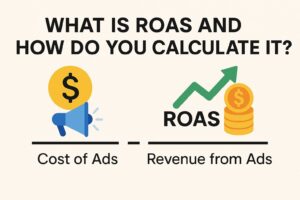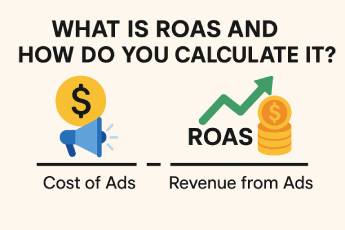
In this competitive digital market, businesses tend to not foolishly spend on advertising. Every rupee or dollar put into it must have measurable results, and marketers must have a proper means to know where campaigns are effective. ROAS (Return on Ad Spend) is a much-needed performance statistic that directly correlates ad spending with revenue outcomes.
ROAS gives a clear financial perspective on how much revenue is generated for each unit of currency spent on advertising, unlike vanity metrics. Businesses might take note of it to determine which initiatives can provide value, adjust ad strategy, and make data-driven budget decisions that promote growth.
What is ROAS?
ROAS stands for Return on Ad Spend, and it is used to calculate the revenue generated for each unit of currency expenditure on the advertisement. To put it simply, it gives you how much capital your company generates in comparison to how much you spend on advertising.
A high ROAS indicates that your campaign is functioning successfully and generating significant returns.
A low ROAS shows inefficiency, implying that the campaign or the ad needs more creativity or better targeting.
How to calculate ROAS
The formula to calculate ROAS is very easy.
ROAS = Revenue from Ads ÷ Cost spent on Ads
Step-by-Step Examples:
Assume you paid ₹20,000 on a Meta Ads campaign.
And the campaign raised around ₹80,000 in direct revenue.
ROAS = 80,000/20,000 = 4:1.
Which means for every ₹1 you spend, you can earn ₹4 back.
Key points to consider:
Attribution matters: Make sure that income is correctly assigned to the campaign.
Do not neglect additional costs: It’s important to check product costs, operating expenses and profit margins to get the whole view of profitability, as ROAS only compares ad expenditure to revenue.
Benchmarks vary:A decent ROAS varies by sector and business strategy. For e-commerce, 4:1 may be regarded as healthy; however, for subscription-based enterprises, even 2:1 may be profitable owing to repeat business.
Conclusion
ROAS is more than just a measuring system; it provides a performance indicator for your marketing budget. By calculating and tracking ROAS, businesses can identify efforts, decrease underperforming ads, and allocate funds better. It doesn’t matter if you are conducting a small startup campaign or taking care of massive ad budgets; tracking ROAS makes sure that your ads don’t just raise visibility but also generate demonstrable financial returns.
At Impulse Digital, we use ROAS to improve brand ads. From developing accurate targeting strategies to creating captivating creatives and optimising campaigns across platforms, our data-driven approach guarantees that every dollar spent works harder. We don’t just track returns; we constantly improve campaigns to help organisations achieve sustainable growth and maximum long-term profitability.
Use data-driven ad strategies to create more intelligent growth; get in touch with Impulse Digital today. https://www.theimpulsedigital.com/


